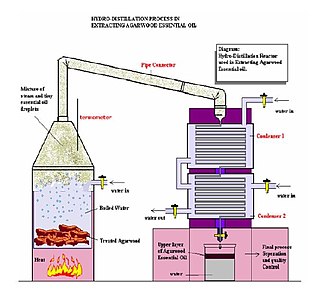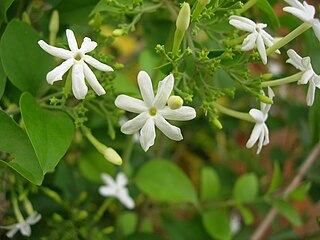Related Research Articles

A rose is either a woody perennial flowering plant of the genus Rosa, in the family Rosaceae, or the flower it bears. There are over three hundred species and tens of thousands of cultivars. They form a group of plants that can be erect shrubs, climbing, or trailing, with stems that are often armed with sharp prickles. Their flowers vary in size and shape and are usually large and showy, in colours ranging from white through yellows and reds. Most species are native to Asia, with smaller numbers native to Europe, North America, and northwestern Africa. Species, cultivars and hybrids are all widely grown for their beauty and often are fragrant. Roses have acquired cultural significance in many societies. Rose plants range in size from compact, miniature roses, to climbers that can reach seven meters in height. Different species hybridize easily, and this has been used in the development of the wide range of garden roses.

Rose water is a flavoured water made by steeping rose petals in water. It is the hydrosol portion of the distillate of rose petals, a by-product of the production of rose oil for use in perfume. Rose water is also used to flavour food, as a component in some cosmetic and medical preparations, and for religious purposes throughout Eurasia.
Perfume is a mixture of fragrant essential oils or aroma compounds (fragrances), fixatives and solvents, usually in liquid form, used to give the human body, animals, food, objects, and living-spaces an agreeable scent. Perfumes can be defined as substances that emit and diffuse a pleasant and fragrant odor. They consist of manmade mixtures of aromatic chemicals and essential oils. The 1939 Nobel Laureate for Chemistry, Leopold Ružička stated in 1945 that "right from the earliest days of scientific chemistry up to the present time, perfumes have substantially contributed to the development of organic chemistry as regards methods, systematic classification, and theory."

Cananga odorata, known as ylang-ylang or cananga tree, is a tropical tree that is native to the Philippines, Malaysia, Indonesia, New Guinea, the Solomon Islands, and Queensland, Australia. It is also native to parts of Thailand and Vietnam. It is valued for the essential oils extracted from its flowers, which has a strong floral fragrance. Ylang-ylang is one of the most extensively used natural materials in the perfume industry, earning it the name "Queen of Perfumes".

Chrysopogon zizanioides, commonly known as vetiver and khus, is a perennial bunchgrass of the family Poaceae.

Rasgulla is a syrupy dessert popular in the eastern part of South Asia. It is made from ball-shaped dumplings of chhena dough, cooked in light sugar syrup. This is done until the syrup permeates the dumplings.

Rose oil is the essential oil extracted from the petals of various types of rose. Rose ottos are extracted through steam distillation, while rose absolutes are obtained through solvent extraction, the absolute being used more commonly in perfumery. The production technique originated in Greater Iran. Even with their high price and the advent of organic synthesis, rose oils are still perhaps the most widely used essential oil in perfumery.
Mithai (sweets) are the confectionery and desserts of the Indian subcontinent. Thousands of dedicated shops in India, Bangladesh, Nepal, Pakistan and Sri Lanka sell nothing but sweets.

Rooh Afza is a Pakistani drink, and is a concentrated squash. It was formulated in 1906 by Hakim Abdul Hameed and introduced by Hakim Hafiz Abdul Majeed, and launched from Old Dehli, British India. Currently, Rooh Afza is manufactured by the companies founded by him and his sons, Hamdard Laboratories (Waqf) Pakistan, Hamdard India and Hamdard Laboratories (Waqf) Bangladesh. Since 1948, the company has been manufacturing the product in Pakistan, India and Bangladesh.

Fragrance extraction refers to the separation process of aromatic compounds from raw materials, using methods such as distillation, solvent extraction, expression, sieving, or enfleurage. The results of the extracts are either essential oils, absolutes, concretes, or butters, depending on the amount of waxes in the extracted product.

Herbal distillates, also known as floral waters, hydrosols, hydrolates, herbal waters, and essential waters, are aqueous products of hydrodistillation. They are colloidal suspensions of essential oils as well as water-soluble components obtained by steam distillation or hydrodistillation from plants and herbs. These herbal distillates have uses as flavorings and cosmetics. Common herbal distillates for skincare include rose water, orange flower water, and witch hazel. Rosemary, oregano, and thyme are hydrosols that may be used in food manufacturing.

Hamdard Pakistan, is a Pakistani unani medicine company which is based in Karachi, Pakistan. It was established by Hakim Said as Hamdard Laboratories (Waqf) in 1948.

Eau de toilette is a lightly scented perfume. It is also referred to as aromatic waters and has a high alcohol content. It is usually applied directly to the skin after bathing or shaving. It is traditionally composed of alcohol and various volatile oils. Traditionally these products were named after a principal ingredient; some being geranium water, lavender water, lilac water, violet water, spirit of myrcia and 'eau de Bretfeld'. Because of this, eau de toilette was sometimes referred to as "toilet water".

Attar, also known as ittar, is an essential oil derived from botanical or other natural sources. Most commonly these oils are extracted via hydrodistillation or steam distillation. The Persian physician Ibn Sina was the first to derive the attar of flowers from distillation. Attar can also be expressed by chemical means but generally natural perfumes which qualify as attars are distilled with water. The oils are generally distilled into a wood base such as sandalwood and then aged. The aging period can last from one to ten years depending on the botanicals used and the results desired. Technically attars are distillates of flowers, herbs, spices and other natural materials such as baked soil over sandalwood oil/liquid paraffins using hydrodistillation technique involving a still and receiving vessel. These techniques are still in use at Kannauj in India.

Kewra, keora or kewda is an essential oil distilled from the male flower of the fragrant screwpine. The plant is native to Tropical Asia, Southeast Asia and Australasia, and the oil is used as a flavoring agent throughout much of these regions.

Jasmine is considered the queen of flowers and is called the "Belle of India" or the "Queen of fragrance" as it is exquisitely scented to soothe and refresh. In different parts of India it is called by different names—Mogra, Motia, Chameli, Malli puvvu, Jaati, Mulla, Mallige, Juhi, Mogra or Moonlight in the grove. It is reported that there are 300 varieties of jasmine. It is also stated that jasmine crossed the seas—from Asia to Europe, landing first along the Mediterranean Sea, conquering Greece and Turkey, reaching Western Europe through Spain, then France and Italy and finally landing in England in the latter part of the 17th century..

Pandanus odorifer is an aromatic monocot species of plant in the family Pandanaceae, native to Polynesia, Australia, South Asia, and the Philippines, and is also found wild in southern India and Burma. It is commonly known as fragrant screw-pine.
Ganjam Kewda is a male flower of the fragrant screwpine plant used for extracting kewda oil in India. A native to the tropics, it is registered under the Geographical Indications (GI) of Goods Act by Government of India. Kewda scent is produced in Chhatrapur, Brahmapur, Gopalpur and Jagannathpur in district of Ganjam, Odisha. Although kewda plants can be found through most of India, 90% of the commercial production of the kewda flower is estimated to occur in the Odisha state.

Kannauj Perfume, also known as Kannauj Ittar, is a traditional Indian perfume made in the city of Kannauj in Uttar Pradesh.
References
- ↑ "G.I. APPLICATION NUMBER - 228" (PDF). Geographical Indications Journal. 2011. Archived from the original (PDF) on 4 March 2016. Retrieved 6 January 2016.
- ↑ Raju, Chaudhary, K.D., Seema (2003). Geographical Indications in Odisha : A Leading Destination of Traditional Handlooms (PDF). Bhubaneswar: Odisha Review. Retrieved 6 January 2016.
{{cite book}}: CS1 maint: multiple names: authors list (link) - ↑ "Brief Industrial Profile of Ganjam District" (PDF). DCMSME. Micro, Medium & Small Entreprises, Government of India. Archived from the original (PDF) on 4 March 2016. Retrieved 6 January 2016.
- ↑ Sahu, Misra, Deenabandhu, Malaya Kumar (2007). "Ecology and traditional technology of screw pine perfume industry in coastal Orissa". Indian Journal of Traditional Knowledge. 6 (2): 253–261. Archived from the original on 4 March 2016. Retrieved 6 January 2016.
{{cite journal}}: CS1 maint: multiple names: authors list (link) - ↑ "Kewda, From the Travel Journal. Kewda - Orissa's Fragrant Floral King". whitelotusaromatics.com. Archived from the original on 5 February 2016. Retrieved 30 January 2016.
